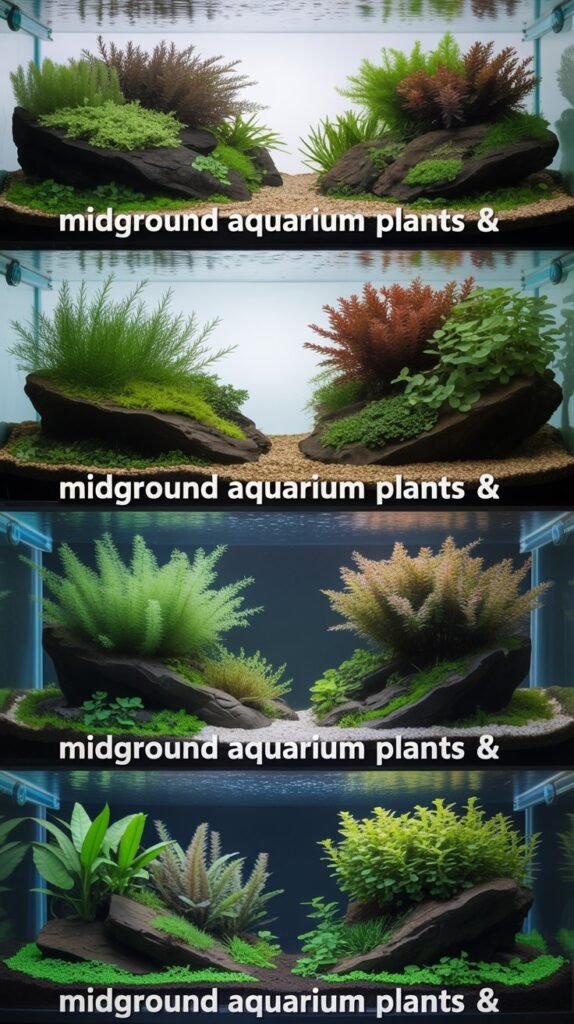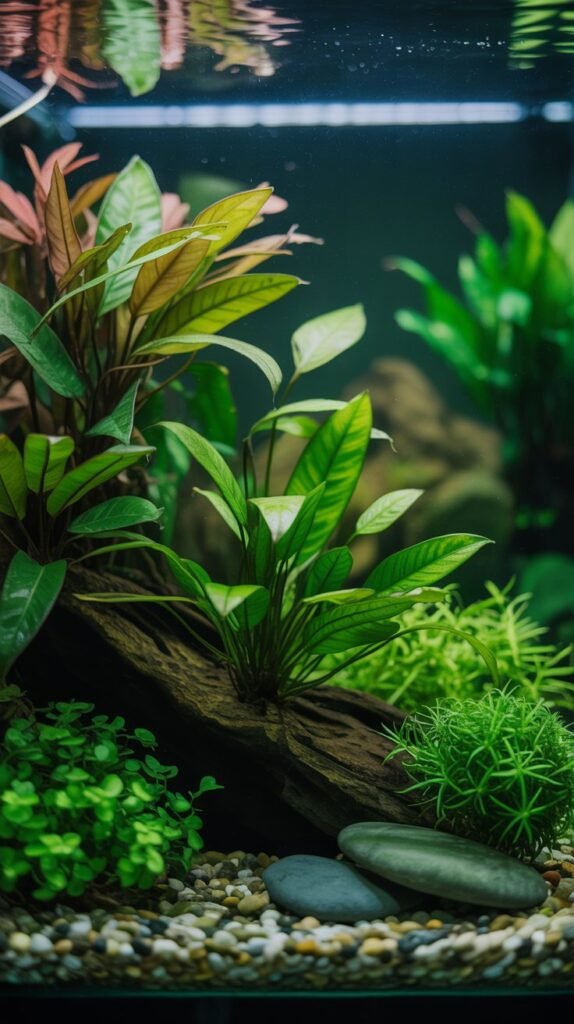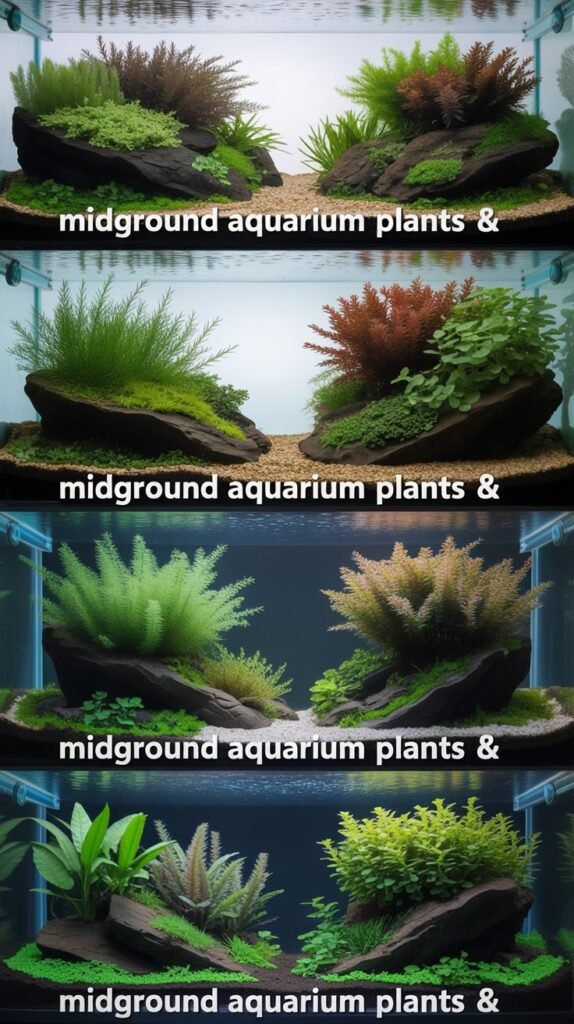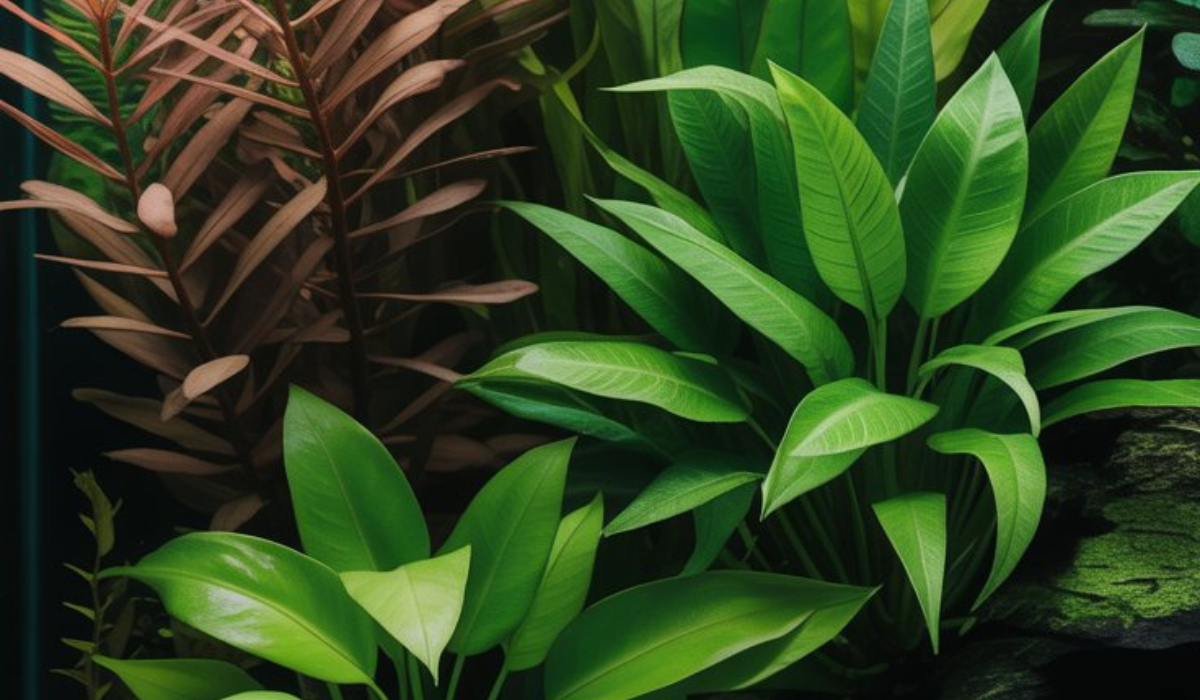Creating a stunning and balanced aquascape is all about harmony — the right combination of plants, textures, and heights that bring your underwater world to life. While foreground plants carpet your substrate and background plants add height and depth, it’s the midground aquarium plants that create a seamless transition between the two.
Midground plants are the unsung heroes of aquascaping, providing structure, contrast, and a natural look to any aquarium setup. In this detailed guide, we’ll explore the best midground aquarium plants, how to care for them, planting techniques, aquascaping tips, and more.
What Are Midground Aquarium Plants?
Midground aquarium plants are aquatic plants that are placed between the foreground (front) and background (back) sections of your tank. Their medium height and lush appearance help bridge the gap between low-growing carpets and tall background species, ensuring a smooth visual transition.
Typically, these plants reach 4–12 inches (10–30 cm) in height and can serve multiple roles:
- They add volume and layering to aquascapes.
- Provide hiding spaces for small fish and shrimp.
- Create focal points that make your tank look natural and well-composed.
Why Midground Plants Are Important in Aquascaping

Midground plants may not always steal the show, but they play an essential role in creating balance and depth. Here’s why every aquarist needs them:
1. They Provide Visual Depth
Without midground plants, your aquascape might look flat or disjointed. These plants help create a 3D illusion, drawing the viewer’s eye naturally from the foreground to the background.
2. Natural Transition Between Layers
They blend the shorter carpet plants and taller background plants seamlessly, ensuring no harsh visual breaks.
3. Shelter for Fish and Shrimp
Many fish species, especially shy or small ones, use midground plants as hiding spots or resting areas. This helps reduce stress and encourages natural behavior.
4. Prevent Algae Growth
By occupying the mid-layer space, these plants compete with algae for nutrients and light, helping maintain a healthy aquarium environment.
5. Aesthetic Diversity
With various shapes — from bushy to grassy — midground plants allow aquascapers to experiment with textures, colors, and contrast.
Ideal Conditions for Growing Midground Aquarium Plants
Before you choose plants for your aquarium’s mid-section, it’s important to understand their growing requirements. While many midground species are hardy, a few demand special care.
| Condition | Ideal Range |
|---|---|
| Temperature | 22–28°C (72–82°F) |
| pH Level | 6.0–7.5 |
| Hardness | Soft to moderately hard (3–12 dGH) |
| Lighting | Medium to high intensity |
| CO₂ Injection | Optional but enhances growth and coloration |
| Substrate | Nutrient-rich (aquasoil or fine gravel with root tabs) |
Top 15 Best Midground Aquarium Plants
Here are some of the most popular and easy-to-grow midground plants that can transform your aquarium into a lush underwater paradise.
1. Cryptocoryne Wendtii
Scientific Name: Cryptocoryne wendtii
Height: 4–8 inches
Lighting: Low to medium
CO₂: Not required
One of the most versatile and hardy plants, Cryptocoryne Wendtii is a perfect midground choice for both beginners and experts. Available in green, brown, and red variants, it provides a dense and bushy look that complements most aquascapes.
Tip: Allow it time to adapt to new tanks — initial “melt” is normal but temporary.
2. Anubias Barteri var. Nana
Height: 5–8 inches
Lighting: Low to medium
CO₂: Optional
Anubias Nana features broad, dark-green leaves and thrives when attached to rocks or driftwood. It grows slowly but steadily, making it an ideal low-maintenance midground plant.
Pro Tip: Avoid burying the rhizome in the substrate — tie it to decor instead.
3. Java Fern (Microsorum pteropus)

Height: 6–12 inches
Lighting: Low
CO₂: Not needed
This classic plant grows beautifully when anchored to wood or stone. Its long, green leaves add elegant movement to the mid-section of your aquarium.
Fun Fact: Java Fern reproduces through small plantlets that grow on its leaves.
4. Hygrophila Corymbosa ‘Compacta’
Height: 4–8 inches
Lighting: Medium
CO₂: Beneficial
This compact species of Hygrophila features tight clusters of bright green leaves. It grows faster than Anubias or Crypts, making it excellent for filling gaps in your midground.
5. Bucephalandra
Height: 2–6 inches
Lighting: Low to medium
CO₂: Optional
Known for its wavy, colorful leaves and slow growth, Bucephalandra adds exotic beauty to your tank. It’s great for midground detailing or accent points.
6. Staurogyne Repens
Height: 4–8 inches
Lighting: Medium to high
CO₂: Recommended
A compact, bushy plant perfect for adding greenery between foreground carpets and taller background plants. It can also form a low hedge with frequent trimming.
7. Pogostemon Helferi (Downoi)
Height: 4–6 inches
Lighting: High
CO₂: Required for best results
This plant’s curly, star-shaped leaves make it one of the most eye-catching midground choices. Ideal for highlight spots in high-tech aquariums.
8. Alternanthera Reineckii ‘Mini’
Height: 4–8 inches
Lighting: Medium to high
CO₂: Required
If you’re looking for color contrast, this red-leaved beauty is perfect. Its vibrant hues create depth and add vibrancy to green-dominated scapes.
9. Bolbitis Heudelotii (African Water Fern)
Height: 8–15 inches
Lighting: Medium
CO₂: Optional
A stunning fern species with delicate, feathery leaves. It prefers slow-moving water and looks gorgeous attached to driftwood.
10. Echinodorus Tenellus (Pygmy Chain Sword)
Height: 5–10 inches
Lighting: Medium to high
CO₂: Recommended
This plant can be used in both the midground and foreground depending on trimming. Its grass-like appearance adds texture and natural flow.
11. Lilaeopsis Brasiliensis (Micro Sword)

Height: 4–6 inches
Lighting: High
CO₂: Helpful
A dense carpeting plant that also works well in the midground layer, especially in nano tanks.
12. Lobelia Cardinalis
Height: 6–12 inches
Lighting: Medium
CO₂: Optional
This plant displays lush green leaves with a slight purple underside. It thrives in nutrient-rich substrate and is perfect for adding volume to mid-tank regions.
13. Hydrocotyle Tripartita (Japan)
Height: 3–6 inches
Lighting: Medium to high
CO₂: Recommended
This creeping plant forms clusters of clover-shaped leaves, ideal for softening hardscape edges and filling midground gaps.
14. Bacopa Caroliniana
Height: 8–12 inches
Lighting: Medium
CO₂: Optional
A stem plant that grows upward in thick clusters, Bacopa is easy to manage and looks great as a mid-layer filler or side accent.
15. Dwarf Sagittaria (Sagittaria Subulata)
Height: 4–12 inches
Lighting: Medium
CO₂: Optional
Fast-growing and hardy, this grass-like plant spreads quickly, creating a natural meadow-like appearance in your aquarium.
How to Plant Midground Aquarium Plants
Proper planting ensures your midground plants thrive and complement your aquascape’s design.
Step 1: Prepare the Substrate
Use a nutrient-rich substrate or add root tabs before planting. Fine gravel or aquasoil works best.
Step 2: Trim and Clean
Trim damaged or extra-long roots before planting. This encourages healthy regrowth.
Step 3: Placement
Plant midground species slightly behind the foreground but in front of taller plants or hardscape.
Step 4: Spacing
Leave space between plants to allow for spreading and easy maintenance.
Step 5: Initial Care
Reduce lighting slightly for the first week to prevent algae while plants adapt.
Lighting and CO₂ Requirements
Lighting and CO₂ are two major factors that determine how well your midground plants thrive.
| Plant Type | Lighting | CO₂ Requirement |
|---|---|---|
| Low-Light Plants | 6–8 hours/day | Not required |
| Medium-Light Plants | 8–10 hours/day | Beneficial |
| High-Light Plants | 10–12 hours/day | Strongly recommended |
Pro Tip: Invest in a full-spectrum LED aquarium light for balanced growth and vibrant coloration.
Maintenance Tips for Midground Plants
Keeping your midground plants healthy and attractive involves simple but consistent care.
- Regular Trimming:
Prevents overcrowding and keeps your layout organized. - Nutrient Dosing:
Use liquid fertilizers weekly and root tabs every 2–3 months. - Water Changes:
Replace 25–30% of the tank water weekly to maintain nutrient balance. - Check for Algae:
Algae can compete for nutrients — manage light and CO₂ levels to prevent outbreaks. - Monitor Fish Activity:
Some fish like cichlids or goldfish may uproot plants — choose compatible species.
Best Fish and Tank Mates for Midground Plants
Midground plants create perfect hiding spots and territorial boundaries for small to medium fish. Here are great companions:
- Tetras (Neon, Ember, Cardinal)
- Guppies
- Rasboras
- Dwarf Gouramis
- Cherry Shrimp
- Otocinclus Catfish
- Snails (Nerite, Mystery)
Avoid:
- Large or digging fish like Goldfish or Oscar cichlids that may uproot or eat plants.
Aquascaping Ideas Using Midground Plants
1. Nature-Style Aquascape
Combine Cryptocorynes, Java Ferns, and Anubias around driftwood and stones for a lush, natural riverbed effect.
2. Dutch Aquascape
Use colorful midground plants like Alternanthera Reineckii Mini and Lobelia Cardinalis to create rows and contrast with bright greens.
3. Jungle Aquascape
Layer various midground species like Staurogyne Repens and Bolbitis Heudelotii for dense, wild foliage.
4. Iwagumi Layout
Accent hardscape stones with low-growing midground plants such as Pogostemon Helferi or S. Repens for minimalist beauty.
Common Problems and Solutions
| Problem | Cause | Solution |
|---|---|---|
| Yellow Leaves | Nutrient deficiency | Use iron or potassium supplements |
| Melting Leaves | New plant acclimation | Trim and wait for regrowth |
| Algae on Leaves | Excess light or nutrients | Reduce lighting; add algae eaters |
| Slow Growth | Low light or nutrients | Increase fertilization and CO₂ |
| Plants Uprooting | Strong current or fish | Use plant weights or rearrange flow |
Low Maintenance Midground Plants for Beginners
If you’re just starting out, choose hardy species that don’t demand CO₂ or high light:
- Anubias Nana
- Java Fern
- Cryptocoryne Wendtii
- Bucephalandra
- Dwarf Sagittaria
These plants are forgiving, adaptable, and great for learning the basics of planted aquariums.
Advanced Midground Plants for Experienced Aquascapers
For enthusiasts who love experimenting with high-tech tanks, consider:
- Pogostemon Helferi
- Alternanthera Reineckii Mini
- Staurogyne Repens
- Lobelia Cardinalis
- Hydrocotyle Tripartita
These species reward you with vibrant growth and striking coloration when given proper lighting and CO₂.
Conclusion
Midground aquarium plants are the heart of every aquascape, adding texture, depth, and cohesion between layers. Whether you’re crafting a minimalist Iwagumi layout or a dense jungle-style scape, choosing the right plants for your tank’s mid-layer can transform its entire look.
By understanding their needs — proper lighting, nutrients, and placement — you’ll create a visually stunning and ecologically balanced aquarium that thrives long-term.
From hardy species like Java Fern to vibrant choices like Alternanthera Reineckii, midground plants open endless creative possibilities for aquascapers of all levels.
Frequently Asked Questions (FAQs)
1. What are midground aquarium plants?
Midground plants are medium-height aquatic plants placed between foreground and background plants to create balance and depth in aquascapes.
2. Do midground plants need CO₂?
Most midground plants grow well without CO₂, but adding it enhances growth rate and coloration.
3. What’s the best midground plant for beginners?
Anubias Nana and Cryptocoryne Wendtii are ideal for beginners due to their low maintenance and adaptability.
4. Can I use midground plants in a small tank?
Yes, choose compact species like Bucephalandra, Pogostemon Helferi, or Staurogyne Repens for nano aquariums.
5. How much light do midground plants need?
Medium to high light is ideal for most midground plants, but some hardy species grow even under low light.
6. Can midground plants grow on rocks or driftwood?
Yes, plants like Anubias, Java Fern, and Bucephalandra grow best attached to hardscape instead of being buried.
7. Why are my midground plants turning yellow?
Yellowing is usually a sign of nutrient deficiency — dose liquid fertilizers regularly.
8. Do midground plants help prevent algae?
Yes, they compete with algae for nutrients, reducing its growth naturally.
9. How often should I trim midground plants?
Trim every 2–4 weeks depending on growth rate to maintain shape and prevent overcrowding.
10. Can midground plants flower underwater?
Some, like Anubias, may produce small flowers underwater, but it’s rare and mostly decorative.

